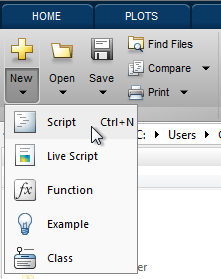Create a Presentation
This tutorial shows you how to create and play a Presentation.
- Step 1: Create a script
- Step 2: Create a canvas
- Step 3: Create a stimulus
- Step 4: Create a controller
- Step 5: Create a presentation
- Step 6: Play the presentation
Step 1: Create a script
Create a new script by selecting New > Script from the MATLAB toolstrip.

Save the script as "tutorial.m" anywhere on your machine.
Step 2: Create a canvas
A Canvas represents an OpenGL context on which to draw visual stimuli. You must have a canvas in order to use Stage and you must have a window in order to create a canvas.
Start the "tutorial.m" script by opening a non-fullscreen, 640x480, window by calling the stage.core.Window constructor.
% Open a window of size 640x480, non-fullscreen
window = stage.core.Window([640, 480], false);
Create a canvas on the window by calling the stage.core.Canvas constructor and passing it the window object.
% Define a window of size 640x480, non-fullscreen
window = stage.core.Window([640, 480], false);
canvas = stage.core.Canvas(window);
Note: If you want to avoid typing the stage.core. prefix before Window and Canvas (and future Stage class constructors), you can add import stage.core.*; as the first line in your script and remove the prefix on subsequent lines.
|
Step 3: Create a stimulus
Create a 200x200 square stimulus at the center of the canvas by instantiating a stage.builtin.stimuli.Rectangle stimulus and setting its position and size properties appropriately.
% Define a window of size 640x480, non-fullscreen
window = stage.core.Window([640, 480], false);
canvas = stage.core.Canvas(window);
% Create the 200x200 square stimulus at the center of the canvas
square = stage.builtin.stimuli.Rectangle();
square.position = [320, 240];
square.size = [200, 200];
Step 4: Create a controller
In order to animate stimuli, you create controllers that modify properties (position, size, orientation, color, transparency, etc.) of stimuli as functions of playback state (e.g. time, frame, etc).
Create a controller to modify the orientation of the square stimulus to rotate it 180-degrees per second.
% Define a window of size 640x480, non-fullscreen
window = stage.core.Window([640, 480], false);
canvas = stage.core.Canvas(window);
% Create the 200x200 square stimulus at the center of the canvas
square = stage.builtin.stimuli.Rectangle();
square.position = [320, 240];
square.size = [200, 200];
% Create a controller to change the square's orientation property as a function of time.
orientationController = stage.builtin.controllers.PropertyController(bar, 'orientation', ...
@(state)state.time * 180);
Step 5: Create a presentation
A Presentation simply serves to collect a set of stimuli and controllers into an experimental trial of given duration.
Create a 5 second presentation and add the square stimulus and orientation controller.
% Define a window of size 640x480, non-fullscreen
window = stage.core.Window([640, 480], false);
canvas = stage.core.Canvas(window);
% Create the 200x200 square stimulus at the center of the canvas
square = stage.builtin.stimuli.Rectangle();
square.position = [320, 240];
square.size = [200, 200];
% Create a controller to change the square's orientation property as a function of time.
orientationController = stage.builtin.controllers.PropertyController(square, 'orientation', ...
@(state)state.time * 180);
% Create a 5 second presentation.
presentation = stage.core.Presentation(5);
presentation.addStimulus(square);
presentation.addController(orientationController);
Step 6: Play the presentation
Finally, play the presentation on the canvas.
% Define a window of size 640x480, non-fullscreen
window = stage.core.Window([640, 480], false);
canvas = stage.core.Canvas(window);
% Create the 200x200 square stimulus at the center of the canvas
square = stage.builtin.stimuli.Rectangle();
square.position = [320, 240];
square.size = [200, 200];
% Create a controller to change the square's orientation property as a function of time.
orientationController = stage.builtin.controllers.PropertyController(square, 'orientation', ...
@(state)state.time * 180);
% Create a 5 second presentation.
presentation = stage.core.Presentation(5);
presentation.addStimulus(square);
presentation.addController(orientationController);
% Play the presentation on the canvas!
presentation.play(canvas);
You should see a spinning square in the middle of the canvas that stops spinning after 5 seconds.
In order to close the window, you must clear all of the objects we created in the script by running clear window canvas square orientationController presentation, or clear all if you have nothing else of value in your workspace. In general however, you'll use the same window/canvas across many presentations.